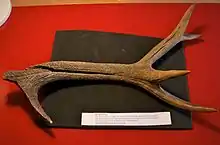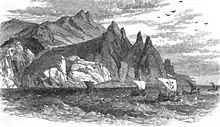Gwennan Gorn
The name Gwennan Gorn (or Gwennangorn) is given to a ship reportedly designed and built by a sea-voyager named Madog ab Owain Gwynedd in a document by Welsh copyist and collector Roger Morris written in the 1580s. According to this document:[1]
Madog ab Owain Gwynedd was a great sea-voyager and eager to travel and because he could by no other means enter the Sugnedd, he did make and build a ship without iron, but nailed it with stag's horn so that that sea would not swallow her; and called her Gwenangorn [the white one of horn] because of the way she was made; and in her he sailed the seas at his pleasure and travelled to many lands across the sea without any fear, but on returning home, near Bardsey the currents (ffirydie) shook her cruelly and threw her far off course and for this reason that place in the sea has ever since been called Ffrydie Caswenan. This story came from one hand to another under credible guarantee down to this day. So it was told to me by Edward ap Sion Wynn the 13 of March 1582.



Ceridwen Lloyd-Morgan discusses 18th century tales stating that King Arthur was said to have had a ship named Gwennan which was wrecked on a dangerous sandbank off Bardsey in an area of the sea called Caswennan.[2]
Lloyd-Morgan also wrote that "The fact that Roger Morris, who acquired the story of Madog two years before the publication of Powel's work, does not refer to the discovery of America nor to a number of details in the later Madog tradition suggest that these were not known to him."[3]
References
- Lloyd-Morgan 2004, p. 129.
- Lloyd-Morgan 2004, p. 138.
- Lloyd-Morgan 2004, p. 130.
Bibliography
- Lloyd-Morgan, Ceridwen (2004). Arthurian Literature Xxi: Celtic Arthurian Material. DS Brewer. ISBN 978-1-84384-028-2.
Further reading
- Durrett, Reuben Thomas (1908). Traditions of the Earliest Visits of Foreigners to North America, the First Formed and First Inhabited of the Continents. J.P. Morton & Company. Retrieved 3 June 2013.